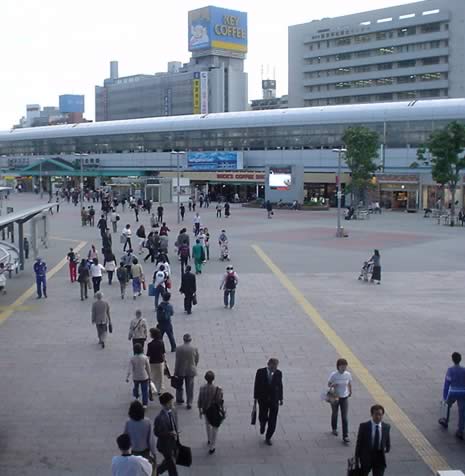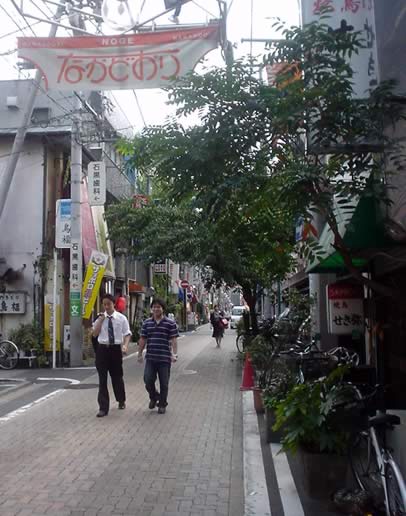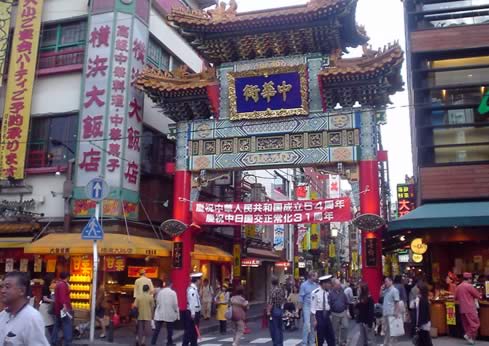This recently rebuilt station provides access to the
Minato Mirai 21 area and Pacifico Yokohama.
Two separate train lines run through this station; the Yokohama City Subway,
and the JR Negishi Line. After it's makeover,
Sakuragicho station has become much more user-friendly with the addition of
several restaurants and coffee shops. Depending on which side of the station
you exit, you enter into two totally different worlds. The west exit will take
you into Noge-cho,
an area filled with drinking establishments which retain some of the feel of
eras gone by. Exiting the station on the east side you are met with Minato
Mirai
21, Yokohama's
vision of the future, the home to the Center.
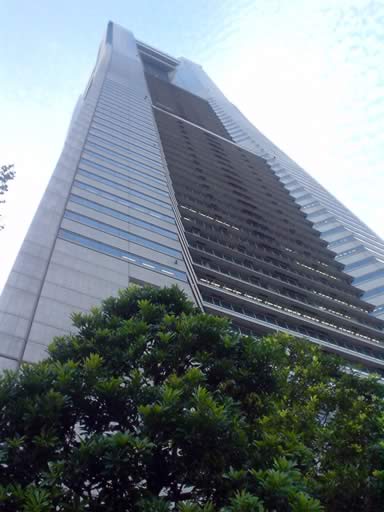
This building is the tallest building in Japan. A shopping mall occupies the
first five floors and is home to several up-scale designer stores but also
includes
some more reasonably priced shops as well. Many Center students make the five
minute walk to Landmark at lunch time to visit the many restaurants there.
Like the shopping, the restaurants also range from expensive sushi or tempura
to budget friendly fast food chains like McDonald's and Wendy's. There is a
food court on the 5th floor with a Sizzler Express salad bar and two floors
underground where you can find many restaurants and beer halls good for an
evening out with friends. Back up on the 5th floor is the store frequented
most by Center students, the Yurindo bookstore. In addition to almost every
currently published Japanese book, Yurindo carries one of the widest ranges
of English magazines and books of all sorts, rivaling the more well-known Shinjuuku
Kinokuniya. On the 13th floor is Forum Yokohama, a reading room and support
center which provides access to information and literature in both Japanese
and English concerning a variety of women's issues and topics of international
cooperation. The friendly staff here are quite helpful to Center students and
the reading room provides a nice quiet atmosphere for research and study. And
for your cultural needs, the Yokohama Museum of Modern Art is situated right
next door to Landmark Tower.

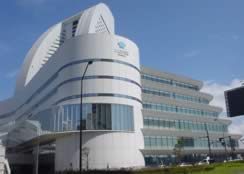
The Center is located on the 5th floor of the Pacifico Yokohama building in Minato Mirai 21. This building, often found on postcards and guide books for Yokohama, is one of the more prominent buildings in Yokohama's skyline. Jutting out along the waterfront, Pacifico Yokohama's unusual architecture is it's most striking feature. This yacht shaped building, completed in 1991, houses a very modern complex of international conference facilities, a number of international organizations and the world-class Inter-Continental Hotel. The Center's residence within this prestigious landmark is due to the warm support of the City of Yokohama. Pacifico Yokohama is bordered to the north by Rinko Park which runs along Yokohama Bay. Next to the park is Pukari Pier which provides ferry service to Tokyo and various locations around Yokohama. While waiting for your ferry to arrive you might want to have lunch or just a cup of coffee at the floating restaurant next door. From here there are beautiful views of the bay and the famous Yokohama Bay Bridge.
Center students who spend most of their day in the ultra-modern Minato Mirai
21 area can sometimes begin to wonder what happened to historical Yokohama.
These concerns can easily be resolved with an excursion to the "other
side" of Sakuragicho Station, Noge-cho. Noge-cho is a popular amusement
center primarily devoted to the numerous drinking establishments and restaurants
which occupy every inch of it's narrow streets. The popularity of this area
among Japanese salary men is most likely due to the good food and cheap prices
of the izakaya drinking halls than the historical value of the area. Yet, for
whatever their reasons, Noge-cho attracts a wide variety of visitors. One of
the more interesting attractions which takes place twice a year is the Noge
Festival which draws many street performers from around the world.
One of the most famous attractions of Yokohama, Chinatown is located between
the Kannai business district and the Motomachi shopping streets, and draws
visitors from all over Japan. Being one of the three largest Chinatowns in
the world, the quality of food is terrific, but watch your wallet as the prices
can get very high. You can spend your whole year at the Center eating in Chinatown
every night and never return to the same restaurant twice. But you'll have
to find your favorite hang out on your own. Hidden away between the restaurants
are several import clothing stores which carry a variety of ethnic clothing,
accessories and housewares from all over the world. If you are like most students
and on a tight budget, it's still a nice place to walk the streets and watch
the people, and if you like, there are many street stalls selling reasonably
priced steamed pork buns and roast chestnuts.
This long stretch of clothing boutiques which boarders China Town is famous
for it's slightly up-scale atmosphere. Shopping here ranges from very pricey
Louis Vitton and Channel boutiques to used clothing stores geared to the high
school crowd. Perhaps the best feature of this street is the Union Supermarket,
a two story import market where you can find many of your favorite items from
back home, plus some unusual delicacies from other cultures. Running parallel
to the shopping street is the back street of Motomachi, an eclectic grouping
of mom and pop stores, flower shops, and several good cafes and restaurants.
Many of these cafes provide a nice quite atmosphere for Center students to
study, or just to read a book. Hovering over these two streets, is the Motomachi
bluff area, home to the foreigners cemetery and many other historical Meiji
period landmarks of the Western settlement. Due to the presence of several
parks in this area, it is a nice place to go when you want to take a walk among
the trees. This area is fairly quiet on the weekdays, but packed with visitors
on the weekend.
